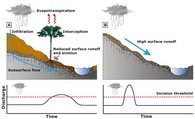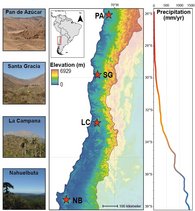Testing biotic controls on erosion and sediment transport in the Chilean coastal cordillera with cosmogenic 10Be-derived erosion rates and a shear stress-based river incision model



Although it is widely understood that organisms directly and indirectly affect erosion and transport processes, their long-term contribution to the evolution of landscapes is not well known. This deficit is rooted in the fact that biotic influences are complex and difficult to disentangle from climatic influences. In this project, we examine the influence of biota on erosion and sediment transport in the framework of a threshold-stochastic stream power model of river incision. We test the hypothesis that biota, the characteristics of soils, and vegetation, influence river incision primarily by modulating the magnitude-frequency distribution of flood events (Figure 1).
To achieve this goal, we will focus on 4 granitic areas that are distributed across a large climate-and-vegetation gradient in the Coastal Cordillera of Central Chile (Figure 2), and address three key objectives:
- Quantify erosion rates with cosmogenic nuclide concentrations in fluvial sediments;
- Quantify the influence of biota on river discharge by analysing a large data set of mean daily discharge records, combined with ecohydrological modelling;
- Model the cosmogenic nuclide-derived erosion rates with a threshold-stochastic stream power model calibrated with discharge distributions and field observations.
Our project thus combines geological / geochemical with ecohydrological / geoecological methods for bridging different time scales, from the stream response to individual rain events to the long-term effect on landscape development.
Project Members
- Dr. Renee van Dongen (GFZ Section 3.3 Earth Surface Geochemistry)
Project Partners
- Prof. Dr. Eva Paton, Geschäftsführende Direktorin des Institutes für Ökologie, TU Berlin
- Dr. Luca Mao, Fluvial Geomorphology, Pontificia Universidad Catolica de Chile, Santiago, Chile
- Dr. Claudio Meier, Civil Engineering, University of Memphis, USA
Time frame
- 2016 - 2019
Funding
- DFG SPP1803: "EarthShape - Earth Surface Shaping by Biota”. DFG-grant SCHE 1676/4-1 to D. Scherler.
Publications
- van Dongen, R., Scherler, D., Wittmann, H., von Blanckenburg, F. (2019): Cosmogenic 10Be in river sediment: where grain size matters and why. Earth Surf. Dynam., vol. 7, p. 393-410, doi:10.5194/esurf-7-393-2019
- Scherler, D., Schwanghart, W. (2020): Drainage divide networks - Part 1: Identification and ordering in digital elevation models. Earth Surf. Dynam., vol. 8, p. 245-259, doi:10.5194/esurf-8-245-2020
- Scherler, D., Schwanghart, W. (2020): Drainage divide networks - Part 2: Response to Perturbations. Earth Surf. Dynam., vol. 8, p. 261-274, doi:10.5194/esurf-8-261-2020


